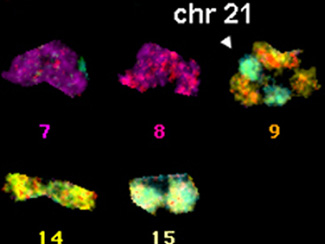Male infertility caused by a chromosomal "miscount"

During meiosis, errors in chromosome segregation lead to aneuploid gametes (with an erroneous number of chromosomes) which might result in male infertility, spontaneous abortions or affected offspring. This work describes for the first time in human spermatogenesis the premature separation of sister chromatids, previously detected in oocytes.
Meiosis is the specialized cell division that gives rise to genetically different gametes, with the chromosome number reduced by half. Therefore, germ cells undergo DNA replication followed by two rounds of divisions: meiosis I (MI) and meiosis II (MII). During meiotic divisions, errors in chromosome segregation lead to aneuploid gametes (with an erroneous number of chromosomes) which might result in male infertility, spontaneous abortions or affected offspring.
In humans, numerical chromosome abnormalities account for about 45% of spontaneous abortions and 5% of stillbirths. Zero-point-three percent of livebirths are born with congenital malformations and mental retardation caused by numerical chromosomal abnormalities, the most frequent of which is Down syndrome (trisomy for chromosome 21).
In our work, we have analyzed meiosis in a testicular biopsy and a semen sample from an infertile male with teratozoospermia and a history of spontaneous abortions in order to detect meiotic abnormalities which might cause his infertility. Molecular cytogenetic techniques were used to detect chromosome aneuploidies at MI, MII and in spermatozoa.
Figure 1. Nondisjunction mechanisms during the first meiotic division, resulting in chromosome abnormalities in the offspring. Adapted from Hassold and Hunt, 2001 (Nat Rev Genet, 2: 280-291).
The frequency of dissociated sex chromosomes in spermatocytes at MI was 41.5%, and subsequent high levels of aneuploidy were found in spermatocyte II and spermatozoa. Two nondisjunction mechanisms have been identified in this individual during the first meiotic division (Figure 1) leading to aneuploid spermatozoa: (1) Two homologous chromosomes which segregate at random due to the absence of chiasmata between them (Achiasmate nondisjunction), and (2) Segregation of sister chromatids at MI (Premature separation of sister chromatids). This last nondisjunction mechanism, previously detected in oocytes, has been described in human spermatogenesis in this work for the first time (Figure 2).
Figure 2. Spermatocyte II karyotype with premature separation of sister chromatids during meiosis I. It has one chromosome 21 (together with chromosome 9) and one extra chromatid 21. A) DAPI staining. B) M-FISH image. Chr: chromosome; Cht: chromatid.
References
"Premature separation of sister chromatids in human male meiosis". Uroz, L; Rajmil, O; Templado, Cristina. HUMAN REPRODUCTION 2008, 23 (4): 982-987.


